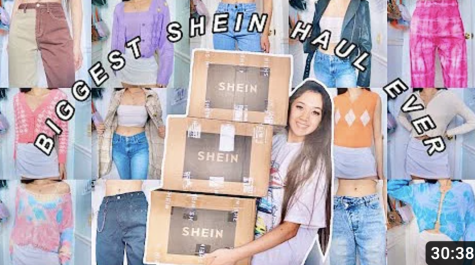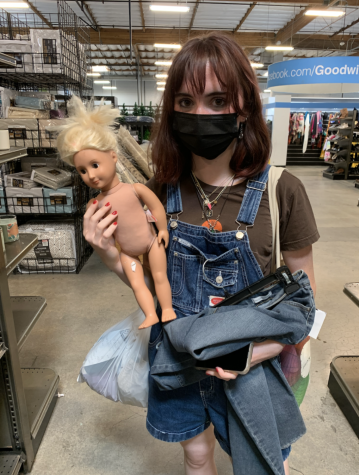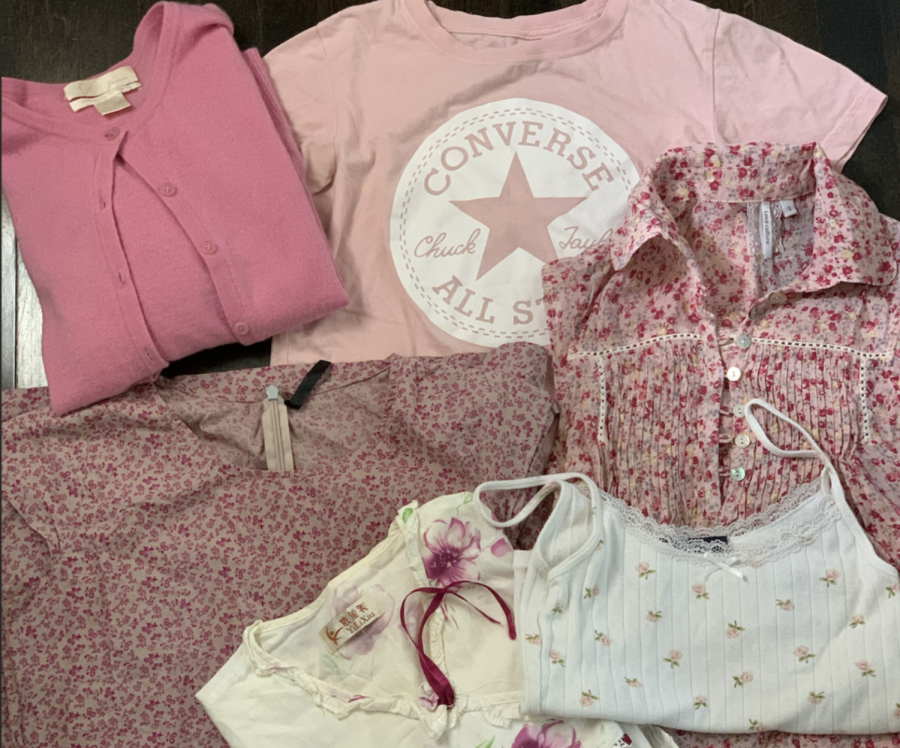Op-Ed: It’s Time to Denormalize Overconsumption and Fast Fashion
A bundle of pink clothes that I have thrifted over time. You can do the same!
Nothing frustrates me more than witnessing the terrible environmental consequences of something so dear to my heart: fashion. I relish in selecting my outfit for the day, filing through the clothing racks at flea markets for hours, and speculating on the meaning behind the costumes worn by movie characters. So you can imagine my annoyance when I find countless examples of people contributing more than their share to the fast fashion industry.
The term “fast fashion” describes cheaply-made garments that are mass-produced by large retailers, often corresponding with the latest trends. With the ever-increasing consumption of fast fashion, the industry is more pervasive than ever—and it’s destroying the planet as a result.
My goal is not to shame people into spending $100 on supposedly ultra-sustainable and ethically made t-shirts from Reformation. My goal also is not to impose a total ban on purchasing fast fashion, a near-impossible commitment in a society with such abundant access to on-demand clothing as well as an infinite preoccupation with consumerism. Fast fashion is everywhere, and while we, as individuals, are not responsible for the corporate greed, humanitarian crises, and negative environmental consequences that arise from the industry, we should also strive to be conscious of what we consume.
By allowing new trends to circulate and catch fire within minutes, social media plays an instrumental role in the new age of fashion. As a social media user myself, not a day goes by that I don’t see or hear about any new, trending fashion pieces. The fast fashion industry utilizes social media to observe the popular outfits of the week and reproduce them quickly enough to remain trendy by the time customers receive the product. With the instant gratification that fast fashion provides alongside the ability to constantly be “on trend,” it’s no surprise that the fashion industry has experienced so much growth within the past few decades.

During the height of the pandemic, videos of users showcasing unusually large purchases of clothing sourced from fast fashion brands, commonly referred to as “hauls,” dominated millions of “For You” pages on TikTok, including my own. Excess differentiates the typical, run-of-the-mill internet haul from the unique breed of “HUGE $1000 SHEIN TRY-ON HAUL” videos that thrived in 2020 and 2021—especially on TikTok and YouTube.
In the comment sections under the TikTok clothing haul videos, I mostly recall people writing sentiments of support and encouragement: “Omg! This is all so cute!” “ I’m so jealous lol,” or, simply, “Yasss!” But occasionally, I noticed people expressing their concerns over the creator’s choice to buy such a large quantity of items from a notoriously unethical brand. A slew of angry replies followed shortly afterward. The replies fiercely defended the creator of the TikTok, blanketly asserting that they did nothing wrong because “there is no ethical consumption under capitalism.” Sometimes they accused the original commenter of being classist. I’m not sure how it could be classist to tell someone with $500 to spend on clothes from SHEIN to redirect their money elsewhere.
Spending $500 at inexpensive fast fashion companies will definitely yield many, many clothes and the opportunity to reinvent an entire wardrobe in accordance with the latest trends, but it comes at the cost of 92 million tons of textile waste generated each year.
SHEIN, a fashion company founded in 2008 by Chris Xu, is notorious for its fast fashion practices. With its astonishingly inexpensive prices, rapid-fire production time, and ever-expanding catalog of garments, SHEIN served as an ideal choice for both creators and consumers on TikTok who wanted to participate in the fashion trends marketed to them by the app’s algorithm. Because of this, the company has absolutely skyrocketed in sales since 2019. According to Business of Apps, SHEIN’s revenue increased 398% from 2019 to 2021. Between 2020 and 2021, SHEIN generated 60% more money, with 2021 bringing in $15.7 billion.

The dramatic uptick in purchases from fast fashion companies like SHEIN generates significantly more clothes–which are being cycled through and disposed of at a high speed. Clothing production doubled from 100 billion units to 200 billion units a year within 2000-2015, while the average uses of a clothing item have decreased 36%. Additionally, the US National Institute of Standards and Technology (NIST) found that over 50 billion garments get thrown out within one year of being produced. By means of poor working conditions, even poorer wages for their employees, and the use of inexpensive, non-biodegradable fabrics, fast fashion companies can endlessly produce clothes that aren’t made to last as functioning articles of clothing, but as scraps in the vast landfills they end up inside of.
While SHEIN remains a popular target for criticism regarding fast fashion, they are certainly not the only company that contributes to the environmental repercussions of the fashion trend cycle. Zara, H&M, Urban Outfitters, and others are similarly guilty for their damaging effects on the environment. In fact, almost all big-name clothing companies can be considered purveyors of fast fashion.

With all of its overwhelming, harrowing statistics attached, it’s easy to feel as if addressing the fast fashion crisis in any capacity is futile. After all, the numbers show no signs of the industry slowing down anytime soon. As a result, people may feel comfort or reassurance in their decisions to purchase from fast fashion brands because their limited impact seems so inconsequential to the bigger problem. However, without appropriate nuance, this attitude can quickly become damaging on both sides of the spectrum.
Mandating people into exclusively purchasing clothing from artisans and ethical (but incredibly expensive) brands is harsh, unrealistic, and won’t solve anything—but so is consuming excessive amounts of fast fashion.
Alternatively, I encourage shopping second-hand as a middle ground between the two extremes of fast fashion overconsumption and pricey but environmentally-friendly fashion perfection. Shopping second-hand is accessible, suited to many price ranges, and contributes fewer items to the consumer cycle. As an added bonus, shopping second-hand can be fun! Flea markets and thrift stores make for engaging, creative shopping experiences and outings with friends.

In addition to local thrift stores and larger Goodwill outlets, there are a variety of online stores that sell clothing secondhand. eBay, Thredup, and Vinted are some of my favorites.
By extending the lifespan of clothes that would have otherwise gone to a landfill, thrifting reduces the amount of non-biodegradable waste accumulating on Earth, the hundreds of thousands of tons of microplastics released into the ocean via dumped clothing, and the carbon emissions caused by the production of clothing.
Neither the ethical fashion puritans who scrupulously avoid any mass produced clothing item nor the TikTok influencers who dismiss overconsumption from fast fashion brands under the guise of “no ethical consumption under capitalism” present a perfect solution. Striving for absolute ethical perfection as a fashion consumer only paralyzes us into not trying at all. Avoiding fast fashion when possible is ideal, but that doesn’t mean you can never buy the occasional pair of jeans from Urban Outfitters. Moderation is key! Even by incorporating a little bit of thrifting and upcycling into your wardrobe, and refraining from overconsumption, you can make a difference. Don’t be too critical of yourself—we’re all trying our best.


Reed is a senior, and this is her fifth year on Spyglass and her third year juggling her roles as Editor, Website Manager, and Website Designer. Outside...




























![Dr. Zanita Kelly, Director of Lower and Middle School, pictured above, and the rest of Westridge Administration were instrumental to providing Westridge faculty and staff the support they needed after the Eaton fire. "[Teachers] are part of the community," said Dr. Kelly. "Just like our families and students."](https://westridgespyglass.org/wp-content/uploads/2025/03/dr.-kellyyy-1-e1748143600809.png)



























